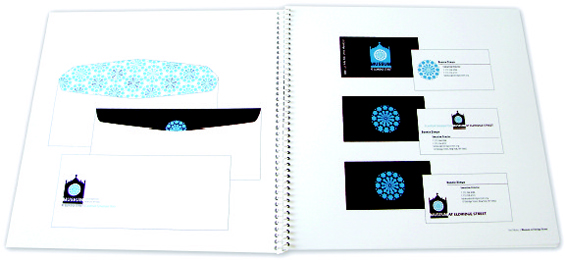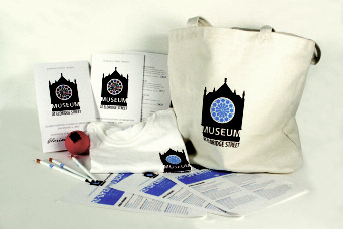Mindy Lang (A’82)/ Art faculty Professional Practice Fall ’07
POSTED ON: June 1, 2008

Museum at Eldridge Street logo designed by Yael Alkalay;spread from presentation book.
The School of Art’s Professional Practice class was my favorite as a Cooper Union student and it has been my privilege to teach the class for the past 15 years. Conceived by former dean George Sadek, Professional Practice provides advanced graphic design students with an opportunity to transform the theoretical to the practical by working with real, non-profit clients. Projects have run the gamut from branding to publications to exhibition design. Noteworthy clients have included The Bronx Museum of the Arts, Cancer Care, Bellevue Hospital and the National Endowment for the Humanities.
This past semester, a group of three students made an enormous impact, developing a new institutional identity for the opening of the Museum at Eldridge Street, the culmination of a 25-year project to restore the Eldridge Street Synagogue in the Lower East Side. Yael Alkalay on exchange from Israel, junior Dan Donohue (A’08) and senior Eli Halpern (A’08) each assumed responsibility for one aspect of the project and together, in one semester, they branded the museum with a new mark and logotype, designed prototypes for important publications and created a motion graphic piece for the museum’s web site and multimedia presentations.
 The semester began with an on-site meeting with deputy director, Amy Milford, who led us on an awe-inspiring tour through the construction site that would become the interior of the sanctuary. Perched 70 feet high on scaffolding—examining details of the trompe l’oeil finishes that no one can get close to now that the building has reopened—we were regaled with stories about the building’s past and the Herculean effort it has taken to bring it back from the dead. We were all moved by the project’s vision to turn this working-class synagogue into a multi-cultural institution serving future generations of immigrants in New York City.
The semester began with an on-site meeting with deputy director, Amy Milford, who led us on an awe-inspiring tour through the construction site that would become the interior of the sanctuary. Perched 70 feet high on scaffolding—examining details of the trompe l’oeil finishes that no one can get close to now that the building has reopened—we were regaled with stories about the building’s past and the Herculean effort it has taken to bring it back from the dead. We were all moved by the project’s vision to turn this working-class synagogue into a multi-cultural institution serving future generations of immigrants in New York City.
“When you talk about design in the classroom,” says Alkalay, “it relates to the experimental and conceptual. The Professional Practice class taught me to think about the design’s function and the client’s needs. It’s a completely different experience and dialogue.” The students began the design process and, as with all Professional Practice projects, there were several weeks of in-class critiques before a presentation was made to the client. Approximately eight weeks into the project, the class returned to the museum offices and presented their work to an overwhelmingly positive response.
“We were seeking a logo design that conveyed the idea that we are creating a major, new cultural institution within an iconic landmark building. This creative and talented team of young designers came up with a concept that is both beautiful and on-message. Working with them was a delight,” says Bonnie Dimun, executive director at the museum. The second half of the semester was spent working on applications of the new design. On December 3, 2007, the Professional Practice class was invited to the grand re-opening of the building, where the new logo was on view everywhere—from the event program to pencils and t-shirts in the museum shop. We were all quite proud to see our semester’s work displayed so prominently.




